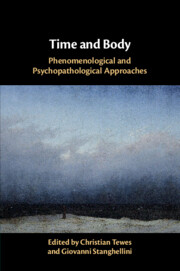Book contents
- Time and Body
- Endorsements for Time and Body
- Time and Body
- Copyright page
- Dedication
- Additional material
- Contents
- Figures
- Contributors
- 1 Introduction – Time and Body
- 2 Time, the Body, and the Other in Phenomenology and Psychopathology
- Part I Body and Time: General Aspects
- 3 The Body – Another
- 3.1 Commentary on “The Body – Another: Phenomenological and Psychoanalytic Perspectives”
- 4 The Heart of Darkness of the Living Body
- 4.1 Commentary on “The Heart of Darkness of the Living Body”
- 5 Microphenomenology of Chronicity in Psychosomatic Diseases
- 5.1 Commentary on “Microphenomenology of Chronicity in Psychosomatic Diseases: Diabetes, Anorexia, and Schizophrenia”
- 6 Time and Embodiment in the Process of Psychotherapy: A Dynamical Systems Perspective
- 6.1 Commentary on “Time and Embodiment in the Process of Psychotherapy: A Dynamical Systems Perspective”The Musicality of Human Interaction
- Part II Grief and Anxiety
- Part III Borderline Personality and Eating Disorders
- Part IV Depression, Schizophrenia, and Dementia
- Index
- References
4 - The Heart of Darkness of the Living Body
from Part I - Body and Time: General Aspects
Published online by Cambridge University Press: 30 October 2020
- Time and Body
- Endorsements for Time and Body
- Time and Body
- Copyright page
- Dedication
- Additional material
- Contents
- Figures
- Contributors
- 1 Introduction – Time and Body
- 2 Time, the Body, and the Other in Phenomenology and Psychopathology
- Part I Body and Time: General Aspects
- 3 The Body – Another
- 3.1 Commentary on “The Body – Another: Phenomenological and Psychoanalytic Perspectives”
- 4 The Heart of Darkness of the Living Body
- 4.1 Commentary on “The Heart of Darkness of the Living Body”
- 5 Microphenomenology of Chronicity in Psychosomatic Diseases
- 5.1 Commentary on “Microphenomenology of Chronicity in Psychosomatic Diseases: Diabetes, Anorexia, and Schizophrenia”
- 6 Time and Embodiment in the Process of Psychotherapy: A Dynamical Systems Perspective
- 6.1 Commentary on “Time and Embodiment in the Process of Psychotherapy: A Dynamical Systems Perspective”The Musicality of Human Interaction
- Part II Grief and Anxiety
- Part III Borderline Personality and Eating Disorders
- Part IV Depression, Schizophrenia, and Dementia
- Index
- References
Summary
A detailed phenomenological analysis of the various manifestations of corporeality can help to grasp and make sense of how the body is apprehended in different psychopathological conditions. I will argue that once distinguished the body-object (the representational, explicit and ultimately visible manifestation of one's corporeality) from the lived body (the proto-reflexive semi-experiential/semi-representational manifestation of one's corporeality), the latter should be distinguished from the living body. What I will call here the ‘living body’ is the immediately felt, pathic, purely impressive, pre-reflective, non-representational, experiential and invisible manifestation of one's corporeality. I will also propose that the living body possess two distinct profiles: self-affection or the primordial bodily chiasm enforcing one's feeling of belonging to oneself and to the world, and the sheer flesh or chaotic plurality of invisible bodily forces immediately felt without the intercession of a representation. A further manifestation of corporeality is the body-for-others; that is the experience of feeling one's corporeality when it is looked at by another person. I will match these different profiles of corporeality to specific anomalous psychopathological conditions, namely the appearance of the sheer, chaotic flesh to the borderline person's form of existence; the body as a corporealized, restricted, inhibited and rigid body to melancholia; the mechanic, robotic functioning object “out there” to schizophrenia; and finally the body apprehended through the gaze of the other to the existence of persons with eating disorders
Keywords
- Type
- Chapter
- Information
- Time and BodyPhenomenological and Psychopathological Approaches, pp. 60 - 75Publisher: Cambridge University PressPrint publication year: 2020



